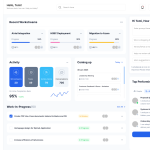In today’s competitive business environment, data-driven decision making is essential for success. With an ever-increasing volume of data available, leveraging artificial intelligence to make sense of this information has become crucial. Studies from McKinsey indicate that organizations that rely on data-driven decisions are 5% more productive and 6% more profitable than their competitors. This article delves into how AI transforms decision-making processes by analyzing data, uncovering hidden patterns, and providing actionable recommendations.
The Fundamentals of Data-Driven Decision Making
Data-driven decision making involves collecting, analyzing, and applying data to guide business strategies. Core components include:
- Data Collection:
Amassing data from diverse sources, including sales, customer interactions, and operations. - Data Analysis:
Utilizing AI and machine learning algorithms to identify trends, correlations, and anomalies. - Actionable Insights:
Converting data into practical recommendations that drive strategic initiatives.
Role of AI in Enhancing Decision Making
AI systems excel at processing large datasets far more efficiently than human analysts. Key capabilities include:
- Predictive Analytics:
Forecasting future trends based on historical data, allowing proactive adjustments. - Real-Time Reporting:
Providing up-to-date metrics and insights, ensuring decisions are based on the latest information. - Automated Summaries:
Generating concise summaries of complex datasets for quick understanding.
TurboMode AI Spotlight
TurboMode AI integrates with data-driven decision-making platforms by automating the extraction of actionable items from meetings and discussions. This ensures that valuable insights are promptly converted into tasks and strategic actions.
“We’re shifting the game from managing work to getting work done.”
Experience how TurboMode AI can enhance your data-driven decisions—book a demo today.
Implementing AI-Driven Analytics
- Consolidate Data Sources:
Integrate data from CRM, ERP, and other platforms into a unified database. - Select the Right Tools:
Choose AI and machine learning tools that can process and visualize data effectively. - Establish KPI Frameworks:
Define the key performance indicators that align with your strategic goals. - Real-Time Monitoring:
Implement dashboards that provide up-to-date insights for agile decision making. - Feedback and Adaptation:
Regularly review analytics and refine decision-making processes based on performance data.
Real-World Applications
A global retail chain implemented an AI analytics platform to monitor customer behavior and optimize inventory levels. The result was a 15% increase in sales and a 10% reduction in overstock situations. Similarly, a financial services firm used predictive analytics to adjust investment strategies in real time, leading to improved portfolio performance and reduced risk exposure.
Challenges and Considerations
- Data Quality:
The effectiveness of AI tools is heavily dependent on the accuracy and completeness of the data. - Integration Complexity:
Merging data from different systems can be challenging—robust data infrastructure is essential. - User Adoption:
Ensuring that decision-makers trust and understand AI-generated insights is key to successful implementation.
Future Trends in Data-Driven Decision Making
- Enhanced Personalization:
AI may eventually deliver personalized insights tailored to individual roles within the organization. - Increased Automation:
Future systems could fully automate certain decision-making processes, allowing managers to focus on strategic planning. - Integration with Advanced Visualization:
Interactive dashboards with augmented reality features might soon provide even deeper insights into complex data sets.
Conclusion
Data-driven decision making is the cornerstone of modern, agile organizations. With AI enhancing the speed, accuracy, and relevance of data analysis, businesses can make better decisions that drive productivity and growth. Integrating platforms like TurboMode AI further accelerates this process by ensuring that insights are not only generated but also acted upon efficiently. Embrace AI to transform your decision-making framework and secure a competitive edge in the rapidly evolving marketplace.






